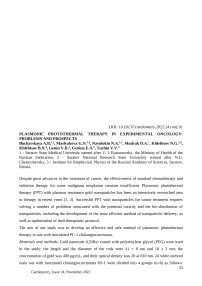Plasmonic photothermal therapy in experimental oncology: problems and prospects
Автор: Bucharskaya A.B., Maslyakova G.N., Navolokin N.A., Mudrak D.A., Khlebtsov N.G., Khlebtsov B.N., Genin V.D., Genina E.A., Tuchin V.V.
Журнал: Cardiometry @cardiometry
Статья в выпуске: 24, 2022 года.
Бесплатный доступ
Despite great advances in the treatment of cancer, the effectiveness of standard chemotherapy and radiation therapy for some malignant neoplasms remains insufficient. Plasmonic photothermal therapy (PPT) with plasmon resonance gold nanoparticles has been an intensively researched area in therapy in recent years [1, 2]. Successful PPT with nanoparticles for tumor treatment requires solving a number of problems associated with the potential toxicity and the bio-distribution of nanoparticles, including the development of the most efficient method of nanoparticle delivery, as well as optimization of their therapeutic protocol. The aim of our study was to develop an effective and safe method of plasmonic photothermal therapy in rats with inoculated PC-1 cholangiocarcinoma.
Короткий адрес: https://sciup.org/148326308
IDR: 148326308 | DOI: 10.18137/cardiometry.2022.24.conf.16
Текст статьи Plasmonic photothermal therapy in experimental oncology: problems and prospects
1 - Saratov State Medical University named after V. I. Razumovsky, the Ministry of Health of the Russian Federation, 2 - Saratov National Research State University named after N.G. Chernyshevsky, 3 – Institute for Biophysical Physics of the Russian Academy of Sciences, Saratov, Russia.
Despite great advances in the treatment of cancer, the effectiveness of standard chemotherapy and radiation therapy for some malignant neoplasms remains insufficient. Plasmonic photothermal therapy (PPT) with plasmon resonance gold nanoparticles has been an intensively researched area in therapy in recent years [1, 2]. Successful PPT with nanoparticles for tumor treatment requires solving a number of problems associated with the potential toxicity and the bio-distribution of nanoparticles, including the development of the most efficient method of nanoparticle delivery, as well as optimization of their therapeutic protocol.
The aim of our study was to develop an effective and safe method of plasmonic photothermal therapy in rats with inoculated PC-1 cholangiocarcinoma.
Materials and methods . Gold nanorods (GNRs) coated with polyethylene glycol (PEG) were used in the study; the length and the diameter of the rods were 41 ± 8 nm and 10 ± 2 nm; the concentration of gold was 400 μg/mL, and their optical density was 20 at 810 nm. 24 white outbred male rats with inoculated cholangiocarcinoma RS-1 were divided into 4 groups (n=6) as follows: 33 Cardiometry, Issue 24, November 2022
the comparison group covering the rats without any exposure; the group with a single intravenous injection of GNRs and a single applied PPT procedure; the group with a double intravenous injection of GNRs and two PPT procedures, and the group with three intravenous injections of GNRs and three PPT procedures; in all groups, a dose of 2 mg/kg of GNR was used per injection.
Prior to the injection of GNRs, the rats were scanned with Doppler-sonography using the Voluson E8 Expert Ultrasound Machine (GE Healthcare, USA) and applying the VOCAL software (Medison-Kretz) with the determination of the tumor volume and the vascularization index. A day after the last injection of GNRs, PPT was performed according to the protocol previously developed for intratumoral administration of GNRs [2] using the 808-nm IR laser LS-2-N-808-10000 (Laser Systems, Ltd., Russia) with a power density of 2.3 W/cm2. The temperature of local heating of the tumor was measured using the IRI4010 IR thermograph (IRISYS, UK).
Half of the animals were removed next day after the therapy completion, and in the remaining animals, the tumor growth was monitored for 3 weeks. To assess an accumulation of gold by atomic absorption spectroscopy (AAS) and morphological examinations, tumor samples were taken. The microvascular density in the tumor was determined in the field of view of the histological specimen using the digital image analysis system of the medical microvisor of type µVizo-103 LOMO.
Results . The Doppler sonography showed that when the tumor reached a certain volume in a range from 5 cm3 to 10 cm3, the vascularization index increased with an increase in the tumor volume. When analyzing the temperature indicators of local heating of the tumor, it was revealed that the temperature rose above 60ºС for an efficient PPT procedure, only when the value of the tumor vascularization index reached at least 0.15. There was a relationship between the vascularization index and the gold content in the tumor after repeated intravenous injections of GNRs. At lower values of the vascularization index, there was a smaller accumulation of gold in the tumor tissue with multiple intravenous injections of GNRs.
A positive correlation was found between the index of vascularization and the index of microvascular density of the tumors which was consistent with the data of other authors [3].
Conclusion . The study demonstrated that an efficient PPT procedure with repeated intravenous injections of GNRs required a well-formed vascular network in the tumor.
Список литературы Plasmonic photothermal therapy in experimental oncology: problems and prospects
- Huang X., Jain P.K., El-Sayed I.H., El-Sayed M.A. Plasmonic photothermal therapy (PPTT) using gold nanoparticles. Lasers Med. Sci, 2008; 23: 217-228.
- Bucharskaya A.B., Maslyakova G.N., Chekhonatskaya M.L., Terentyuk G.S., Navolokin N.A., Khlebtsov B.N., Khlebtsov N.G., Bashkatov A.N., Genina E.A., Tuchin V.V. Plasmonic photothermal therapy: approaches to advanced strategy. Lasers Surg. Med. 2018; 50(10): 1025- 1033.
- Yang W.T., Tse G., Lam P., Metreweli C, Chang J. Correlation between color power Doppler sonographic measurement of breast tumor vasculature and immunohistochemical analysis of microvessel density for the quantitation of angiogenesis. Ultrasound Med. 2002; 21: 1227.


